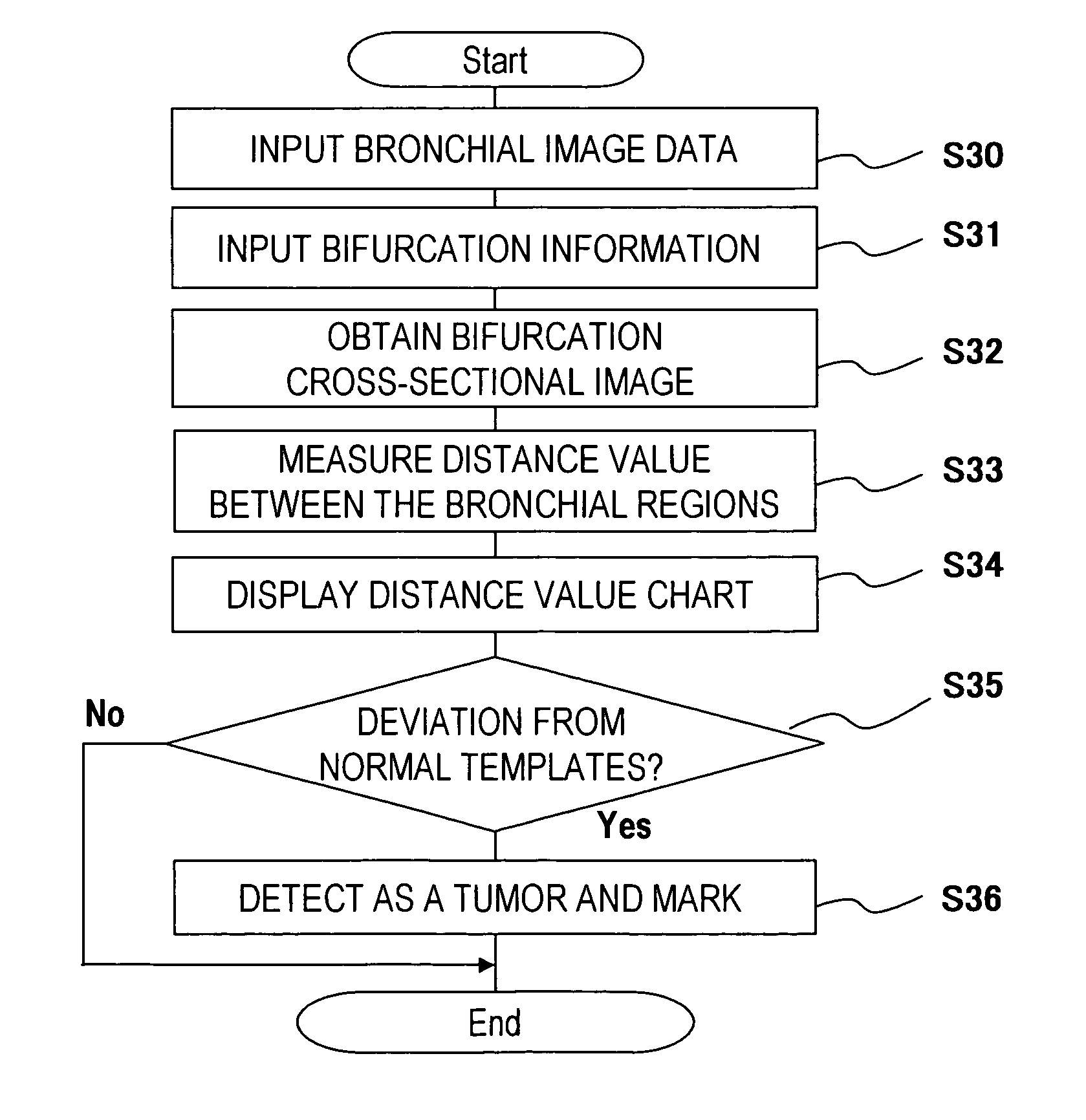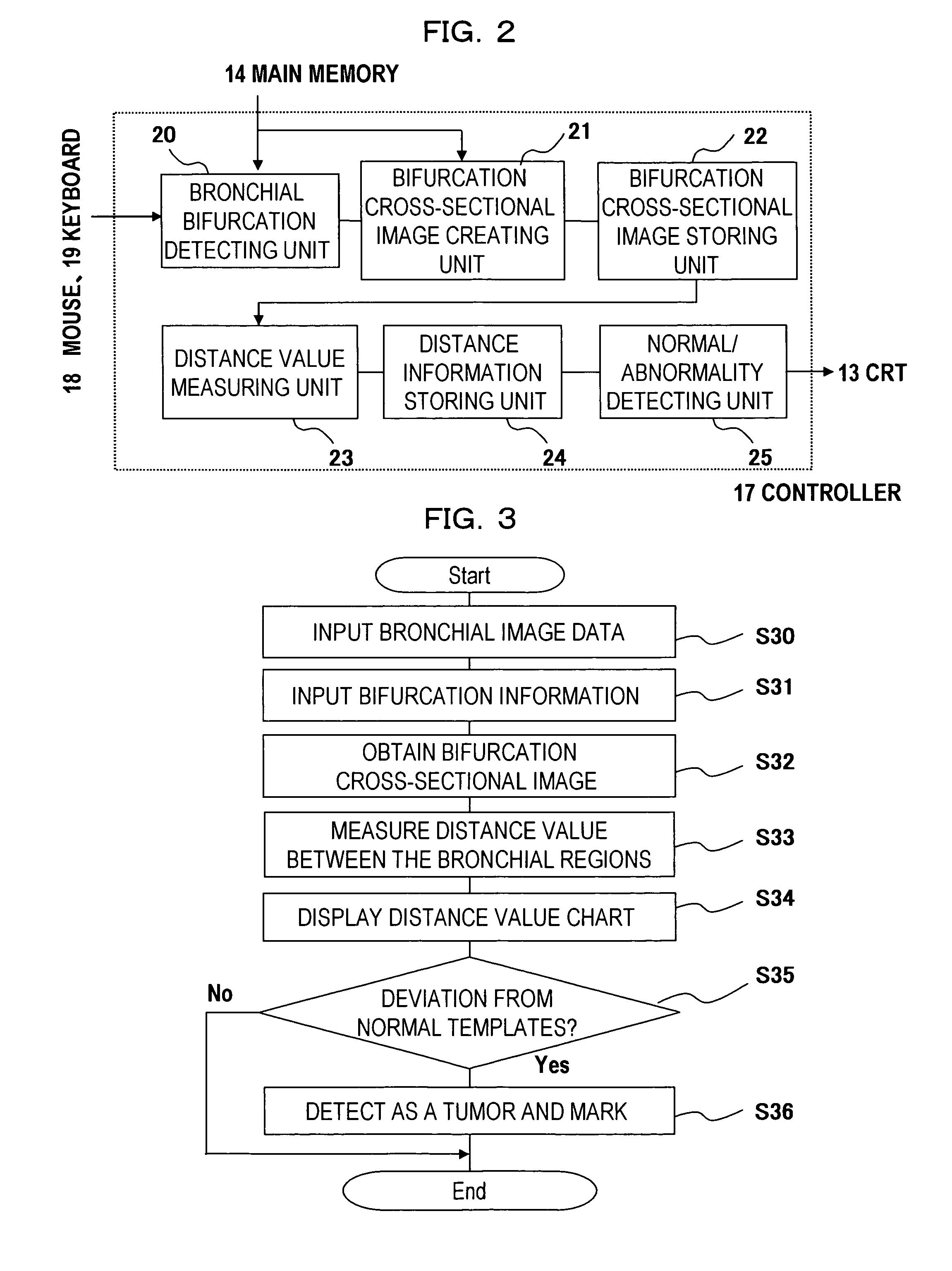Medical image diagnosis support device and method for calculating degree of deformation from normal shapes of organ regions
a technology of supporting device and imaging image, which is applied in the field of medical image diagnosis support device for supporting image diagnosis, can solve the problems of imposing strain on the subject and taking a long time to perform an examination on each patient, and achieve the effect of improving the efficiency of diagnosis
- Summary
- Abstract
- Description
- Claims
- Application Information
AI Technical Summary
Benefits of technology
Problems solved by technology
Method used
Image
Examples
first embodiment
The First Embodiment
[0116]FIG. 3 is a flow chart explaining the operation example of the first embodiment, and FIGS. 4 to 8 are the explanatory diagrams of steps S31˜S36 in FIG. 3.
[0117](Step S30)
[0118]An examiner (an operator) operates mouse 18 or other input device, and inputs to controller 17 the medical image data being read out from main memory 14.
[0119](Step S31)
[0120]The examiner (the operator) operates mouse 18, and inputs to controller 17 the bronchi bifurcation information from main memory 14 or other memory device. The bifurcation information here indicates the coordinate of the bifurcation and the direction vector of the bifurcation. The direction vector of the bifurcation indicates the vector that points to the direction of the bronchi right before the bifurcation as arrow 41 in FIG. 4.
[0121](Step S32)
[0122]Controller 17 creates the several pieces of the cross-sectional images that are orthogonal to the direction vector of the bifurcation as seen in a group of cross-sec...
second embodiment
The Second Embodiment
[0135]FIG. 9 is a flow chart explaining an operation example of the second embodiment, FIG. 10 is an explanatory diagram of step S92 in FIG. 9, FIGS. 11 and 12 are the explanatory diagrams of step S93 in FIG. 9, and FIG. 13 an explanatory diagram of step S95 in FIG. 9.
[0136](Step S90)
[0137]An operator operates mouse 18 or other input device, and inputs the medical image data being read out from main memory 14 or other memory device to controller 17.
[0138](Step S91)
[0139]The operator operates mouse 18, and inputs the information on bronchi bifurcation from main memory 14 to controller 17. The information on the bronchi bifurcation here means coordinates of the bifurcation and the vector direction of the bifurcation.
[0140](Step S92)
[0141]Controller 17 creates cross-sectional image 101 including vector direction 100 of the bifurcation as seen in FIG. 10, based on the inputted medical image data and the information of the bronchi bifurcation.
[0142](Step S93)
[0143]Co...
third embodiment
The Third Embodiment
[0152]FIG. 15 is a block diagram illustrating a detailed example of a controller in FIG. 1 for explaining the third and fourth embodiments.
[0153]Controller 17, as illustrated in FIG. 15, includes:
[0154]hollow viscera extracting unit 150 being electrically connected to mouse 18, keyboard 19 and main memory 14;
[0155]notable region setting unit 151 being electrically connected to mouse 18, keyboard 19 and hollow viscera extracting unit 150;
[0156]hollow viscera cross-sectional image creating unit 152 being electrically connected to notable region setting unit 151;
[0157]lesion candidate detecting unit 153 being electrically connected to hollow viscera cross-sectional image creating unit 152; and
[0158]lesion candidate detecting result storing unit 154 being electrically connected to lesion candidate detecting unit 153.
[0159]Hollow viscera extracting unit 150 is for extracting the notable hollow viscera from the medical image being inputted from modality 1B via main mem...
PUM
 Login to View More
Login to View More Abstract
Description
Claims
Application Information
 Login to View More
Login to View More - R&D
- Intellectual Property
- Life Sciences
- Materials
- Tech Scout
- Unparalleled Data Quality
- Higher Quality Content
- 60% Fewer Hallucinations
Browse by: Latest US Patents, China's latest patents, Technical Efficacy Thesaurus, Application Domain, Technology Topic, Popular Technical Reports.
© 2025 PatSnap. All rights reserved.Legal|Privacy policy|Modern Slavery Act Transparency Statement|Sitemap|About US| Contact US: help@patsnap.com



